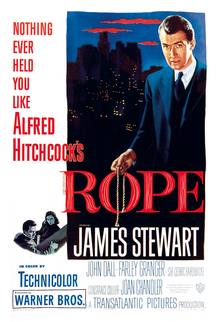Constructed entirely from
uncut ten-minute shot, Rope (1948) is one of Alfred Hitchcock’s more
experimental films even though it didn’t work out. “Alfred Hitchcock called Rope an ‘experiment that didn’t work
out’, and he was happy to see it kept out of release for most of three decades.
Rope remains one of the most
interesting experiments ever attempted by a major director working with
box-office names, and it’s worth seeing [...].” (Roger Ebert, 1984).

Rope’s argument is about the Nietzschean
philosophy between a couple of students and their professor. Hitchcock also
plays with situations involving the inconvenience of dead bodies; but this
doesn’t make the film successful: “Also the emphasis on the macabre in this
small story is frightfully intense. And it seems to this public observer that
time could be better spent than by watching a waspish cocktail party in a room
with a closely present corpse, placed there by a couple of young men who have
killed for a thrill and nothing more.” (Bosley Crowther, 1948).
It starts with Brandon (John
Dall) and Phillip (Farley Granger) who are two young college students who want to
prove their intellectual superiority. So they kill their friend David Kentley
(Dick Holan) and hide his body in an unlocked trunk where a party is taking
place and dinner is going to be served. The guests of this party are David’s
father Mr. Kentley (Cedric Hardwickle), his aunt Mrs. Atwater (Constance
Collier), his fiancée Janet (Joan Chandler), his best friend Kenneth (Douglas
Dick) and their college professor Rupert Cadell (James Steward). They are all
aware of what has happened. But their professor starts to suspect and he
finally discovers that Brandon and Phillip have killed David.

The strong performance from
Dall, Granger and Steward creates drama and suspense. But, as Bosley Crowther
of The New York Times said, “the novelty of the picture is not in the drama
itself, it being a plainly deliberate and rather thin exercise in suspense, but
merely in the method which Mr. Hitchcock has used to stretch the intended
tension for the length of the little stunt for a story of meager range” (Bosley
Crowther, 1948). The camera follows the killers wherever they go, their goings
and their comings, so it seems as if they are caught.
Hitchcock had to deal with
time and space. This means that there can’t be jumps in time, or the suspense
will be lost. The audience must know that the body is always in the trunk. The
play is an 80 minutes scene taken in ten minutes long segments. It was not
edited and there are not visible cuts between the segments. It seems as if all
the events take place in one uninterrupted act, as a continuous shot. And this
is why Alfred Hitchcock’s Rope is
well known for.
Illustration list:
Figure 1. Rope [Poster] At: https://en.wikipedia.org/wiki/Rope_(film)#/media/File:Rope2.jpg
Figure 2. Rupert, Brandon and Phillip [Film Still] At: http://www.jasonbovberg.com/hitchcock-conversations-rope-1948/
Bibliography:
Fernando F. Croce (2006) Rope At: http://www.slantmagazine.com/film/review/rope
Pamela Hutchinson (2012) My favourite Hitchcock: Rope At: http://www.theguardian.com/film/filmblog/2012/jul/27/my-favourite-hitchcock-rope
Bosley Crowther (1948) The Screen In Review; ‘Rope,’ an Exercise in
Suspense Directed by Alfred Hitchcock, Is New Bill at the Globe At: http://www.nytimes.com/movie/review?res=980DE3D81630E03BBC4F51DFBE668383659EDE
No comments:
Post a Comment